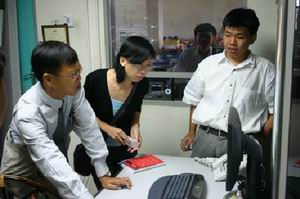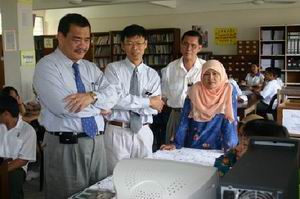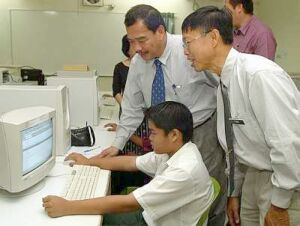Archive for the ‘RFID’ Category
RFID – A Case Study – SMJK Dindings, Lumut, Perak

This Malaysian school is adopting an innovative interdisciplinary approach to learning, and their philosophy to managing their human resources and physical assets. Starting November 2004, they will be using the MiFare RFID tags to take student time and attendance and access control to their server room. They may expand their use to include RFID smart labels to identify and secure assets such as library books, notebooks and other assets. While the use of RFID in schools is not widespread at this time; the integration of the RFID tags with the existing School Management Systems will make this school more efficient in their monitoring functions.
Mr Tiong Ting Ming, a well-known pioneer of ICT deployments in schools, is a strong believer in using technology to aid in normal day-to-day teaching, learning and administration. He understands that the tasks of managing school involves working with information and building on teaching ideas collaboratively. The efficiency and effectiveness of this management task can be enhanced significantly through the use of technology.

Tiong has been looking at ways to supplement his School Management Systems for attendance tracking for students and staff; he did a pilot implementation last month to record the time of day students arrive in the morning with an initial issuance of 200 RFID cards and with 10 classrooms mounted with the RFID readers that were linked centrally to his School Management Server in the School. The pilot launch was to look at how users react and responded to the new technology before a full scale launch when school resumes in. Eventually he’d like to expand the system to track students’ punctuality (or lack thereof) for every class and to verify the time they get in and out of school, with an option for parents to be notified by SMS.

If funding is available, he plans to experiment with the use of the RFID’s 1 K information storage to track library loans, disciplinary records and with visits to the disciplinary office; where transactions will be recorded on the RFID chip.
“That way, we could confirm that a student goes off at 11:15am at the school gate,” Tiong said. “All this relates to attendance and keeping track of kids…. Eventually it will become a monitoring tool for us for all students, including teachers, and we can show parents with the click of a mouse how many times their kids were late or absent from school.”
“Before this, everything was done manually, our teachers would take attendance and send it down to the office, where the admin staffs have to compile and consolidate these attendance records” he said. “Now it’s automatic, and it saves us a lot of time.”
“With the help of Perridot Systems, we will also make full use of this implementation by asking our school security guard to go on a night patrol in the school compound, he will be required to clock in to every assigned school blocks to see that everything is in order at night, or school holidays,†said Tiong. “With this we will be sure he is doing his duty, I can monitor from home to see he is going around the compoundâ€
Radio-frequency identification tags — which have been hailed as the next-generation bar code – consist of a microchip outfitted with a tiny antenna that broadcasts an ID number to a reader unit. The reader searches a database for the number and finds the related file, which contains the tagged item’s description, or in the case of SMJK Dindings, the student’s info.
Unlike bar codes, which must be manually scanned, RFID-tagged items can be read when they are in proximity to a reader unit, essentially scanning themselves. The school uses passive RFID tags that are activated when radio waves from the reader reach the chip’s antenna. (Active RFID tags incorporate a battery that constantly broadcasts the chip’s ID number and are much more expensive.)
The RFID technology adopted by the school is Mifare cards, following the standards set by the government. In the near future, when every student has their new 64K MyKad issued, everyone will carry a ready-made RFID card.
Students in other part of the country can also use their MiFare compliant Touch-N-Go card as Attendance Card as well.
The SMJK school’s 800+ students wear small plastic cards around their necks that have their photograph, name and grade printed on them, together with a bar-code printed at the back of the card, and include an embedded RFID chip. As the students enter the school, they approach an RFID Attendance Reader where a reader activates the chip’s signal and displays their photograph. The students touch their card on the reader, and the time of their entry into the building is recorded in a database.
At the Administration office, or anywhere in the world, with the aid of a browser, a real time online screen will show the time, place and photo of the student entering a specific room in the school.

The school spent RM24,000 on the RFID system. The RM10 RFID tags students wear around their necks at all times incorporate the same RFID smart labels used in the Malaysian Identity card, MyKad.
But the Lumut school is believed to be the first school to use the technology to identify and track students on a campus-wide implementation..
Tiong was tipped off to RFID by their Technology Partner – Perridot Systems Sdn Bhd, an Open Source School Management System solution provider to the school, who had implemented similar RFID solutions to corporate for their ERP systems.
The solution deployed also built privacy protections into the school’s RFID system, including limiting the reading range of the kiosks to less than 4 inches and making students touch the RFID Readers instead of passively being scanned by it. It is the same as swiping a magnetic-strip card for access control, or presenting a photo ID badge to a security guard, both of which are commonplace occurrences.
Tiong said that the RFID-linked databases would require separate passwords to access students’ disciplinary, attendance, results, library and homework records. “It is as private as anything else can be when your information is stored on a server,” he said.
The Star – Perak school transformed to interactive management system

Original Story – The Star
BY CHAN LI LEEN
07/11/2004
LUMUT: From weather-worn wooden huts for classrooms and office buildings, SMJK Dindings in Pundut near here has emerged as one of the most IT-savvy schools in the country.
The 52-year-old school is the first to have a fully integrated School Management System using radio frequency identification (RFID) technology that enables it to record, access, report and manage performance records and data of students and staff in real time.
An attractive feature of the system, developed by Sibu-based company Perridot Systems, is that it allows parents to track their children’s performance and print out e-report cards.
The school’s principal, Tiong Ting Ming, who initiated and carried out the system after his transfer to the school in 1992, said all these functions could be performed anywhere in the world through the Internet.

PRACTICAL SOLUTION: Tiong (right) and Kong observing Form Three student Loke Zhao Lin showing how the School Management System allows students to sit for a mock examination on Friday.
“All that is required is the password and one’s username. The system, however, has pre-defined parameters whereby an individual can only access information that is relevant to the person,” he told reporters here during a visit by Deputy Science, Technology and Innovation Minister Datuk Kong Cho Ha yesterday.
Tiong said the school was also using the system to track library loans, disciplinary records, and as a monitoring tool to record students’ punctuality and whereabouts.
“Each student has his own RFID tag. The student is required to scan it at readers within the school to keep track of his movement.
“The school and parents can confirm what time students arrive and leave, and their attendance at each classroom session,” said Tiong.
He said past and present students of the school had helped set up the system, including wiring up the school buildings with fibre optic cables.
“All equipment were either donated or bought second-hand,” he added.
Commending Tiong and the school for their efforts, Kong said having the School Management System had helped to boost the school’s reputation, and enrolment had risen from 320 students in 1992 to about 800 at present.
“The school’s popularity is growing so much so that parents are insisting on sending their children here,” said Kong, who is also Lumut MP.
He also urged Perridot Systems and the school to market the management system overseas.
“Software developed in our country are impressive but people have this mindset that they are only good if other countries have used them before.
“Therefore, the trick is to market them overseas first,” he added.